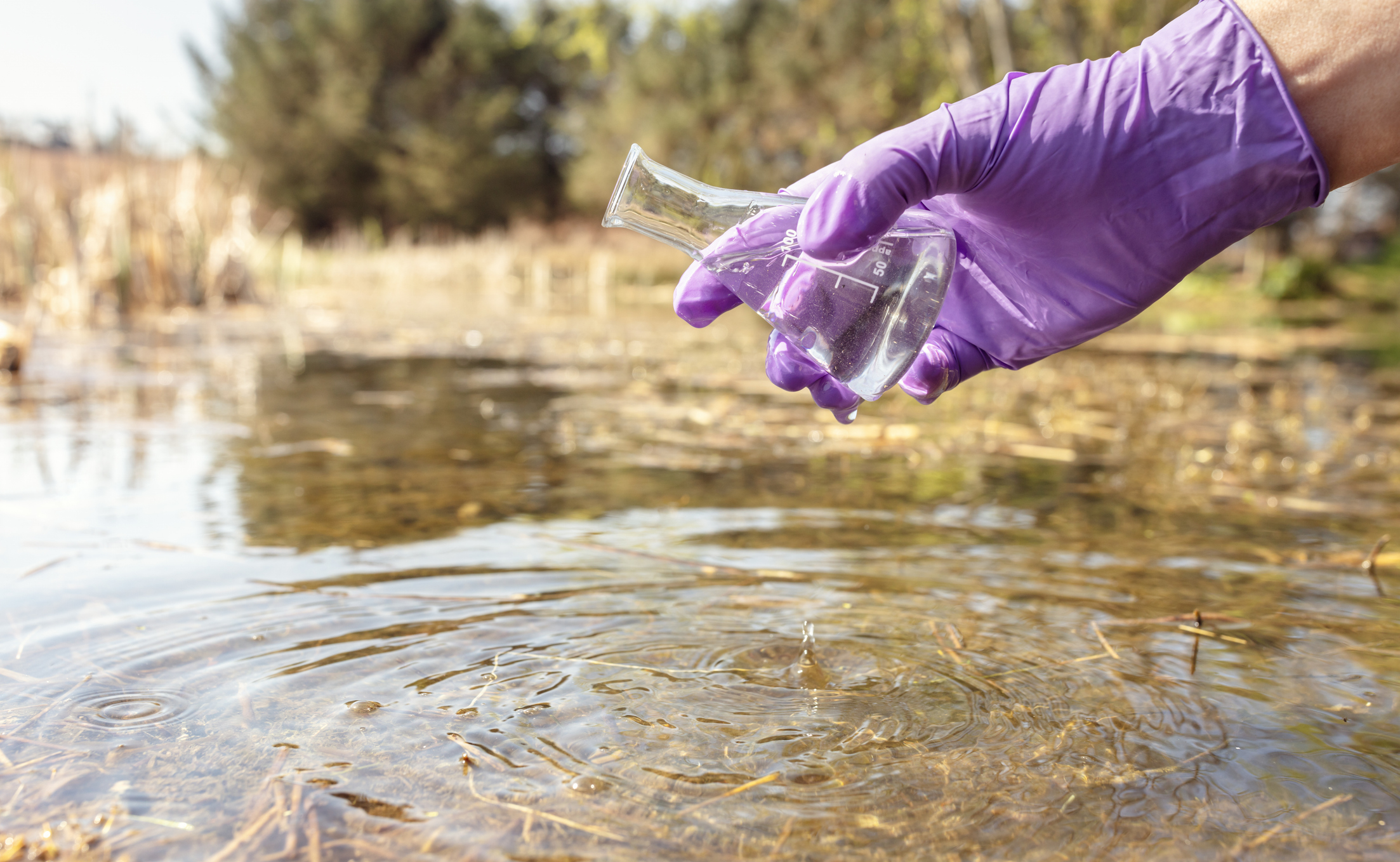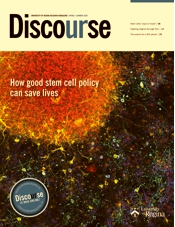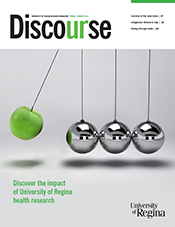University of Regina physicist Zisis Papandreou holds a Gadolinium Aluminium Gallium Garnet (GAGG) scintillator, surrounded by a white light diffuser that mixes light uniformly inside of it. Immune to magnetic fields, GAGGs are used in modern clinical systems that have a PET (Positron Emission Tomography) scanner inside MRI (Magnetic Resonance Imagine) systems in hospitals. (Photo by Trevor Hopkin)

In a world battered by divisive politics and growing distrust, Zisis Papandreou is like a breath of fresh air.
The head of the University of Regina (U of R) physics department, Papandreou is an internationally renowned nuclear physicist whose insight and collaboration skills are in demand around the globe. He brings scientists together to address the growing impact of environmental degradation and climate crises.
“I love to collaborate – it fuels me,” he says. “I love to find experts to complement what I know. It used to be that things were very proprietary, and some professors were even known to hide data from their students for fear of losing out on a great discovery. But that should be a thing of the past. Whether it’s finding a vaccine for COVID or coming up with solutions to tackle climate change, we can’t have guarded secrets.”
Papandreou is like an open-source textbook, willing to share his expansive knowledge with the world and create a high level of cooperation and participation with others. For the past two decades, he has travelled back and forth from Regina, Saskatchewan, to his second home at the renowned Thomas Jefferson National Accelerator Facility in Newport News, Virginia. It’s at Jefferson Lab where physicists study the inner workings of the atomic nucleus and where Papandreou participates in pure and applied lab research, collaborating in the advancement of scientific discoveries.

PHYSICS AND FOOD SECURITY
One of those discoveries is known as the Generation-II BioPETx nuclear imaging detector – one of the world’s most advanced tools for looking inside living plants. Built at the U of R and soon to be housed at the Saskatchewan Centre for Cyclotron Sciences at the University of Saskatchewan (U of S), this detector is based on Positron Emission Tomography or PET. Most people have heard of PET scans in the medical field, where radioactive isotopes are used to detect cancers in the body. An exciting new field of science is now using PET technology to study how plants survive under varying conditions that mimic our changing climate.
“By 2050, there will be 10 billion people living on this planet, and we’ve virtually exhausted all arable land. So the question becomes, how can we make agriculture more efficient and come up with better yields safely and effectively? There is an urgent need to increase agriculture production – especially with drier climates becoming the norm,” he says. “The ultimate goal is greater food security.”
“Zisis Papandreou is one of those rare scientists who has the ability to see big-picture connections,” Weisenberger says.
Jefferson Lab’s chief technology officer, Drew Weisenberger, who also leads the Lab’s Radiation Detector and Imaging Group, says he and his colleagues at Duke University were studying the transportation of carbon dioxide in plants (photosynthesis) using radioactive tracers. Papandreou thought the idea was “so cool” that he created a partnership with Weisenberger and his team to build something similar in Regina, using radiotracers to determine how climate change and environmental degradation are impacting plant structures.
“Zisis Papandreou is one of those rare scientists who has the ability to see big-picture connections,” Weisenberger says. “A lot of scientists can spend their entire lives looking at their own particular problem or research area, but Zisis has this ability to find other ways to use a tool. He sees infinite possibilities and goes about collaborating to make his visions come to life, like the BioPETx to study a plant’s life cycle above and below the soil. His ability to think outside the box and thrive on interconnections is what sets him apart.”
HOW IT ALL BEGAN
How Papandreou became such an innovative physicist is a story that starts with humble beginnings in Estevan, Saskatchewan, where he was born into a Greek immigrant family. His parents moved the family back to Greece when young Papandreou was just eight years old. Of that time, he fondly remembers his love of chemistry sets and “almost setting my dad’s office on fire” with an experiment that went awry.
He studied hard in high school, and initially went into topographical engineering design, when he was lured to the U of R by a scholarship established by a philanthropic Greek expat who was eager to bring Greek students to Saskatchewan. Papandreou studied under professors emeritus Giorgio Papini, a theoretical physicist known for impressive math calculations, and George Lolos, an experimental physicist. He had an opportunity to work at TRIUMF, Canada’s particle accelerator centre in Vancouver, and wound up doing his post-doctorate at Utrecht University in Holland, learning Dutch along the way.
“I was working at Jefferson Lab in Virginia while on tenure track at George Washington University, when an assistant professor position opened up at the U of R. It was a homecoming of sorts, and a great opportunity to take all of my contacts with me and build something special in Saskatchewan,” he says.
A CLOSER LOOK
Unravelling the science behind the Generation-II BioPETx nuclear imaging detector, and the earlier 2017 Generation-I device known as PhytoPET, takes a little explaining.
“What nuclear physicists do to look at the nucleus inside an atom is to crack its outer shell by smashing the atom with an accelerator near the speed of light,” he says. “The nucleus is made up of protons and neutrons. The accelerator lab’s light source is an intense beam of high energy photons that bursts the protons into the tiniest microparticles called quarks. By size comparison, Papandreou explains, an atom is the size of Toronto’s fifty-thousand-seat SkyDome, a nucleus is the size of a pea, and a quark is a fraction of a pin prick.

“When, for example, two vehicles are involved in a serious collision, you often have glass and debris being propelled in all directions,” he says. “Just as an accident reconstructionist can determine speed and angle of impact, the nuclear accelerator at Jefferson Lab is able to study the building blocks of matter, helping to understand the nuclear forces or ‘glue’ that binds them, and ultimately our world, together. The microparticle applications of nuclear physics have a variety of uses, from testing and treating cancer, to energy production, to space exploration. In our work, we use microparticles in agriculture to enhance our understanding of plants, which can benefit food production.”

Papandreou, along with his U of R colleague and co-collaborator Aram Teymurazyan, worked closely with Jefferson Lab to help design and build the nuclear plant imaging system at the U of R. By inserting nuclear isotopes into plants, the physicists get an inside look at a plant’s functional behaviour in much the same way that isotopes are used to see inside a human body to detect cancer.
Teymurazyan says understanding a plant’s tolerance to drought and disease is only one aspect of the amazing BioPETx. “The first prototype that we launched in 2017, working in collaboration with the soil science department at the U of S, used radiotracers to study how bacteria can be used to break down hydrocarbons in the soil – compounds that form the basis of crude oil, natural gas, coal, and other energy sources. This has enormous implications for cleaning up contaminated oilfield sites.”
Designing and building the second-generation BioPETx took an incredible amount of international teamwork.
“A lot of the techniques we’re using here, we learned at Jefferson,” explains Teymurazyan. “A nuclear lab facility is very custom – you just can’t buy it off the shelf or purchase it from a manufacturer. It needs to be constructed piece by piece.”
THE SKY’S THE LIMIT
Similar in principle to Jefferson Lab, the U of S’s Cyclotron is an accelerator of charged protons, able to produce medical isotopes to detect cancers. Radioactive sugar is ingested into the human body, and then moves to where it needs to go to create energy. Because cancers replicate quickly, the radioactive sugar immediately goes to the cancer site to form a heat map. In conjunction with a CT scan, hidden tumours can then be found.
“The Cyclotron has had a huge impact on the health of the people in Saskatchewan,” explains Papandreou, “but it has also benefitted physicists, like myself, who have access to these isotopes. Thanks to our unique partnerships and the support of our funders, we’re taking that medical knowledge and advancing it for plant science.”
While Papandreou and Teymurazyan are both hard-working scientists, Papandreou, with his outgoing personality, naturally falls into the role of global collaborator and communicator. The more reserved Teymurazyan is most at home in his lab, logging the exciting discoveries taking place.
Born and raised in Armenia, Teymurazyan got his PhD at the University of Kentucky, where he also worked closely with Jefferson Lab. He then moved to Toronto in 2009 to perfect his skills in nuclear medicine. His partnership with Papandreou brought him back to the field of nuclear physics research, an area he loves. “In nuclear medicine, you can see results of your research within a year, but with the work I’m now doing in nuclear physics, it can take years, almost a decade, to see results, so it takes patience and persistence,” he says. “The BioPETx is allowing us to study any physiological process in plants, with global implications. Our imagination – like the sky – is the limit.”
“When our detector looks at the root system, it lights up the cameras in a blinding fashion, as if we pointed the camera to the sun.”
For Teymurazyan's current research, he and the team are putting radioactive sugar in a plant, studying its movement under varying atmospheric conditions (mimicking heat, drought, wind, and temperature fluctuations), and then studying how this impacts the root system, which is very sensitive to the microbiome.
“If we cut below the leaf of a canola or lentil plant, for example, the radiotracer moves to the vascular system. But if we cut the stem, the plant recognizes it as a danger and will do everything it can to survive. Essentially, it dumps all of its resources to the root system, which is incredible to see. When our detector looks at the root system, it lights up the cameras in a blinding fashion, as if we pointed the camera to the sun.”
In the past, such studies on the root system had to be conducted on many different plants, effectively killing each plant to obtain key information. Now, that information can be obtained while the plant is still living. “We can do multiple studies in a non-destructive way to the same plant, with the ultimate goal of finding and engineering plants that are best suited for today’s changing climate,” Teymurazyan explains.
Currently, the BioPETx is being refined at the U of R, and will be permanently housed at the U of S.
Teymurazyan’s master’s student Shweta Sharma, from Punjab, India, has been helping to assemble the modules for the BioPETx, working to ensure the detector gets the best-quality plant images possible, which she then analyzes.

The global significance of her work is not lost on the aspiring PhD candidate. “Ensuring food security is a part of human survival, so we must address the challenges the food industry faces,” she begins earnestly. “I never imagined myself working in a lab like this, all the way across the world. It gives me great joy to come to work each day. This is such a great opportunity. My parents are so proud.”
Sharma speaks glowingly of her supervisor, whose approachability, patience, and passion for physics have made her feel right at home. Sharma’s own passion extends to educating people about the importance of nuclear research. “When I mention that I work with nuclear isotopes, people often think of bombs and missiles,” she laughs. “But my work is safe, as long as you follow standards and safety protocols. I feel so proud because we are using nuclear research for good. Climate change is impacting global food production, and we already see that with droughts. Our work will ensure food will be plentiful in the future.”
THE POWER OF TEAMWORK
Papandreou’s ability to assemble such an exceptional team for the common good is inspiring. “Collaboration and healthy competition are needed in this field to bring people together to talk and find commonalities. I’m always looking for ways to work together, especially when it comes to interdisciplinary collaboration. I really enjoy finding biologists and agriculture partners to help bring about important innovations that have the power to change the world,” he says. “We accomplish so much more by working together.”
It’s a credo our beleaguered world could use a little more of, and one that sets Papandreou apart as a man on a mission.
He and his colleagues, along with their many collaborators around the world, believe that real change is within reach, impacting humanity's ability to feed itself as climate changes and population grows. All of this exciting scientific discovery has come about through Papandreou’s natural team-building instincts.

“My ultimate vision is to combine the BioPETx nuclear imaging detector to similar efforts at facilities in the U.S., Germany, and Japan, so we can create tangible food security solutions on a global scale,” he says confidently. “Once the BioPETx moves to Saskatoon later this winter, we will keep advising for up to a year, while simultaneously working to develop new nuclear imaging detectors to respond to a host of complex global issues. We’ll also be collaborating with particle accelerator facilities across North America to pool data and help develop even more discoveries.”
With Papandreou’s collaboration skills at play, and his team’s collective drive, passion, and expertise, the future looks bright.

















